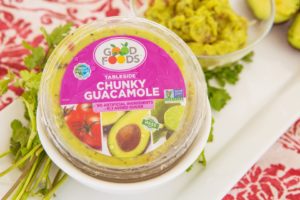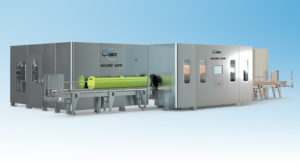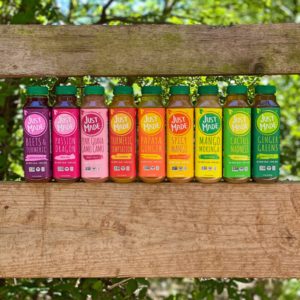Pressure points: High pressure processing excels with produce
Nearly 20 years ago, Good Foods founder Kurt Penn saw what he believed to be the future of food processing technology.
Today, the company he started is at the forefront of adapting and advancing that vision using the high pressure processing that made such an impression.
Attending an industry trade show around 2005, around the time he was selling the company he owned then, Penn saw his first HPP machine. At that time, the technique, which immerses freshly produced products in a cold-water bath and applies uniform pressure of 87,000 pounds per square inch — equal to six times that found at the deepest part of the ocean — was being heavily used by the meat industry as it looked for ways to meet the USDA’s zero-listeria tolerance policy.
HHP was proving to be effective at killing food-borne pathogens while also preserving the nutritional value, appearance and taste that can suffer when products are processed with high temperatures.
“He really couldn’t get it out of his head,” said Joyce Longfield, Good Foods principal of HPP applications. “Even after he was done with the sale of Penn Valley Farms to Perdue, he wanted to start another food company, and he knew that it needed to be utilizing the HPP technology. So even before he had founded Good Foods and had a single recipe developed, he went out and bought an HPP machine. Kind of the cart before the horse, but from there, that has always made our focus be that we are an HPP company that makes food.”
HPP Innovation
The company’s dips, dressing and salads, made at its Prairie View, Wisconsin, headquarters, are particularly amenable to HPP. Fruits such as avocados, sourced from its processing facilities in Tacambaro, Michoacan, Mexico, that go into its guacamoles have a high water content and a solid composition that can hold its structure during the pressurization process.

“Something like a strawberry or a raspberry doesn’t work so well going through the HPP machine, because they have an air pocket inside them and they will collapse,” Longfield said. “They won’t hold the structure. Avocado in slices or guac or mash won’t collapse. That’s why it doesn’t matter what the shape of the size of your package is. You can put a 32-ounce. juice bottle in there.”
Having been ahead of the HPP curve in the mid-2000s, Good Foods is now driving innovation in the industry. The company did a small-scale launch of skin care products using HPP last year that proved the efficacy of the method. Now, it’s investing time and money to investigate how to best market and position skin care solutions to consumers unused to the refrigeration that is required for HPP products.
“We already have the data and the results that demonstrated the benefit of removing those chemical preservatives and using HPP to be the preservation method,” Longfield said. “Now it’s just really about figuring out how we make this the most consumer friendly. We need to be able to get them on board with changing their routine, and that’s a lot to ask.”
But like the Good Foods founder, Longfield is bullish on HPP’s application in the skin care industry and beyond.
“I’m hoping the disruption of the skin care industry will help shine some light on where it’s used in food and in turn drive the demand for it from the consumer side,” she said. “That will help drive the demand for more HPP products, the same way that consumers demand clean labels, preservative-free, low sodium. I’m hoping that with us moving into the personal care side of it, and that really bringing relevance and awareness to the consumer, then they’ll be like ‘Oh wait, this is also used for food? Tell me more. What food is it used for? Where can I find it?’ ”
Industry Disruptor
Errol Raghubeer was also an early adapter of HPP technology. Raghubeer, senior vice president of technology at machine industry company JBT Avure, has been working with HPP since the 1980s, when he helped the U.S. Army study the technology’s suitability for use in MREs.
While that path ultimately did not pan out because of shelf stability issues, Raghubeer knew HPP had many potential applications.

“Around 2000, we decided we’ve gone about as far as we can with a shelf-stable product,” he said. “This application for HPP can only be beneficial and grow if we look at it for refrigerated items. What we have seen over the years is that it has started to expand in a whole lot of different categories, mostly because of the fact that consumers wanted products that were fresher-tasting without the chemical preservatives, and they’re looking for more convenient items that they don’t have to get from the freezer section.”
One industry making visible use of HPP is pet food, where the fresh, refrigerated options popping up in television ads are made with the technology.
“More and more companies now are finding new ways to apply HPP,” Raghubeer said. “Guacamole is well-established worldwide. We have a lot of other products similar to those types that are susceptible to have food safety issues that are applying HPP. … Most of the hummus you get now is an HPP product, because they can remove the sodium benzene and sulfates, and give the consumer a product that has all the nutritional products intact but without the chemicals.”
Another early convert to HPP was the juice industry, which, like ready-to-eat meat, was subject to federal regulations requiring dramatically reduced bacteria levels and longer shelf life.
Walter Nimocks had HPP in mind in 2016 when he started Just Juice, a company featuring tropical juices such as pink guava, papaya, and camu camu — a red/purple, cherry-like fruit that is Nimocks’ favorite.

“I had first seen HPP in 2002,” said Nimocks, who encountered avocado halves in flexible HPP packaging that could last for 45 days. “I remember thinking at the time, ‘I wonder if this would work for juice?’ ”
Initially dissuaded by the cost of HPP machines, which can exceed $3 million, Nimocks discovered a toll processor near his company’s Houston headquarters. Essentially contract manufacturers, toll processors allow companies to test and develop products without the capital commitment needed for something like an HPP machine.
“I spent the most of time looking for someone that would bottle the juice for us. That was really the hurdle that I had to overcome,” Nimocks said. “I did find a copacker that I worked with for about the first seven or eight months, but I was losing money with every bottle because the costs were so high. So we ended up opening our own facility, and we do all the bottling ourselves. We do all the fruit processing and everything here. We take it to the toll processor to have them HPP it.”
While plastic remains the preferred HPP medium because of its flexibility, the packaging process recycles up to 95% of the water used each cycle, Longfield said. HPP also only draws electricity until reaching the required 87,000 pounds of psi. Nimocks is hopeful that packaging advances can produce degradable or compostable plastic capable of withstanding HPP, but the method remains the best solution for marketing the product Nimocks first began envisioning in the 1990s.
Living in various South American countries as part of a lifelong career in the food industry, Nimocks fell in love with both exotic fruits and his wife, Norka, the Just Juice co-founder who hails from Ecuador.
“It was very common for us to have freshly made juice every morning, and it was always something different,” he said. “ … The thing that I’ve learned the most since starting the business is on the QA (quality assurance) side. Juice is its own set of rules, and it’s a very delicate product. You have to take extra precautions when it comes to processing fruits, processing juices, managing temperature, managing time, and of course the HPP helps with the quality aspect as well. It allows us to extend shelf life.”
HPP also has potential applications in processing raw milk without destroying its immunological properties, Raghubeer said, and the technology could also see increased pharmaceutical uses in areas such as vaccine production.
It’s a world of possibilities Kurt Penn foresaw nearly two decades ago, even though Longfield said companies back then scoffed at the idea of consumers paying a few cents more per pound for a premium category of hummus or guacamole.
“Cleary they were wrong,” she said. “Like a lot of what we’ve seen in the last five to 10 years, when you have a company who is disruptive to a category, the risk is high, but the reward is also potentially great. “That’s really what we’re doing now with skin care, is disrupting the industry, and you wouldn’t be able to do this if you did not have a technology like HPP.”










